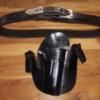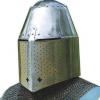All Activity
- Past hour
-
Should You Repair Your Leather Furniture or Buy New?
Leather Repair Center posted a blog entry in Leather Repair Center
Leather furniture adds timeless elegance, comfort, and character to any space, but what happens when it starts to crack, fade, or tear? Many homeowners face the same question: Should I invest in leather furniture repair, or just buy something new? Before you rush to replace that worn sofa or scuffed recliner, here’s what you need to consider — and why leather furniture repair might be the smarter, more sustainable choice. 1. What’s the Real Cost of Buying New? Quality leather furniture isn’t cheap. A new genuine leather couch can easily cost $2,000–$5,000 or more. If the frame and structure of your current piece are still solid, replacing it might mean spending thousands of dollars unnecessarily. By contrast, leather upholstery restoration typically costs just a few hundred dollars and can make your furniture look almost new again. 2. Can It Be Repaired? You might be surprised by what can be fixed: Cracks and fading from sun exposure Scratches and pet damage Small punctures or tears Dull, dry, or stained leather Separated seams or worn cushions If the damage is only surface-level, professional leather furniture repair can fully restore the look, feel, and durability, saving you time, money, and hassle. 3. What’s the Sentimental or Style Value? Some furniture has personal or aesthetic value that can't be replaced. Maybe it’s a custom color, a perfectly worn-in shape, or a sentimental piece passed down from family. In these cases, leather upholstery restoration allows you to preserve what you love while giving it new life. 4. Environmental Impact Matters In a city like San Francisco, sustainability is more than a trend — it's a priority. Repairing instead of replacing reduces waste, conserves resources, and supports a more eco-conscious lifestyle. Every time you choose restoration over replacement, you're making a decision that’s better for the environment. 5. When Should You Replace? There are times when buying new may be the better option: If the frame is broken or the structure is unstable If the furniture is extremely outdated and doesn’t suit your needs or space If the cost of restoration exceeds the value of the piece Still, these cases are the exception, not the rule. Final Thoughts Before you haul that old sofa to the curb or start browsing for a new sectional, consider your options. Leather furniture repair is affordable, fast, and eco-friendly. With expert leather upholstery restoration, your favorite chair or couch can look and feel brand new, for a fraction of the cost of replacing it. Want to know if your leather furniture is a good candidate for restoration? Visit Leather Repair Center to learn more or request a quote today. - Today
-

Some exotic inlay for 1911
Stetson912 replied to Stetson912's topic in Gun Holsters, Rifle Slings and Knife Sheathes
You can use 8 oz for the panel then cut v the window from 4 oz and glue it on top. The skiving of the window panel reduces the thickness on the "wings" making it a bit cleaner and I think more comfortable. You need the 8 oz for the holster structure. I jmloke using the 2 layers of 4 oz laminated because it gives me a liner and is a bit stronger. You could take your 8 oz and make the front panel rough out and then the window on top, but then you would have to line the back panel or have a half lined holster hahaha -
Sams Club sells commercial cutting boards. I cut them up with a table saw to get smaller pieces. Great for backer board while using a hole punch and relatively cheap. I think they are about 20x24 inches or so.
-

Some exotic inlay for 1911
fredk replied to Stetson912's topic in Gun Holsters, Rifle Slings and Knife Sheathes
Not as simple a construction as I thought Well done -
Thanks for the spare bobbin identification, I knew it didn't go with the machine and they're smaller than what's on my Consew. Unless anyone reading this thread want's them for cheap I'll list them on ebay. I also think the bobbin winder came from a different machine, I wouldn't think there would be much of a secondary market for that.
-
If you look at the second half of my video above it shows the movement I'm speaking of, but I'm happy to take another video. Oddly enough the hand wheel doesn't move, the motor pully and the whole shaft, all the way out to the sewing head, moves. I'll find something to act as a shim and see what impeding the movement does. Let me know if you would like a separate video. Much appreciated.
-

Some exotic inlay for 1911
Stetson912 replied to Stetson912's topic in Gun Holsters, Rifle Slings and Knife Sheathes
Thanks Sure! Postage may be expensive though haha Thanks! -

singer 45k Singer 45K25 Roller Foot
Constabulary replied to nategines's topic in Leather Sewing Machines
just found a thread from 2024 regarding the Adler Roller Foot. https://leatherworker.net/forum/topic/120449-help-needed-_-cant-find-roller-foot-for-45k89/ Old parts number for the roller foot was 06422 - new parts number is 104220124 College sewing in UK had them (out of stock): https://www.college-sewing.co.uk/104220124-roller-foot-durkopp-genuine.html but sit down before you click the link 😉 (as I said before) Back in the days when my interest in sewing machines started I needed a slide plate for an Adler 104 flat bed machine and IIRC they asked 50€ + tax and shipping but that was w/o spring and and screws. That was just one "Adler parts situation" and soon I figured that certain Singer parts (and their clones like SEIKO f.i.) fit for certain Adler machines as well cause Adler back in the old days copied a lot of parts from Singer 45K´s 😉 That was the time when I discovered College Sewing in the UK and their wide range of Singer parts.... (and Seiko, JUKI.... who cloned Singer and so forth....) So guess why this guy from the land of Pfaff and Alder is so Singer crazy. It´s because of Parts Parts & Parts. But Brexit changed a lot but I´m still Singer crazy.... Still for the same reason. -
Foil Stamping Temperature Testing: Finding the Perfect Temperature To explore how temperature affects foil stamping results, I tested the hot foil machine using Gold Foil on 1mm thick vegetable-tanned leather at three temperatures: 110°C, 120°C, and 130°C. Here’s what I found: 110°C: The foil stamp was clear and sharp with clean, crisp edges, but the overall effect looked flat, lacking gloss and depth. 120°C: Depth and gloss improved significantly; the design appeared vivid with relatively clear edges, although slight edge blurring was visible under close inspection. 130°C: The foil was thick and rich, but edges became smudged and showed signs of bleeding due to overheating. In summary, 110°C is ideal for precise, crisp results, while 120°C strikes the best balance between depth and clarity. Depending on the material, intermediate temperatures like 115°C are also worth trying.
-
Foil stamping has taken the design world by storm. Whether it’s elegant wedding invitations, high-end packaging, or custom leather goods, the shiny metallic allure of foil stamping instantly elevates the look and feel of your work. But achieving flawless foil stamping isn’t always easy. If you’ve ever wondered: Why do my foil-stamped edges look smudged or uneven? How can I achieve a foil design that’s sharp, consistent, and has real depth? Why do some stamped fonts appear flat while others seem to melt into the surface? You’re not alone. These questions trouble designers, hobbyists, and professionals alike. In this article, we’ll dive into why these issues occur—and more importantly, how you can overcome them. Let’s break it all down. 1.Understanding the Foil Stamping Process and Common Issues Foil stamping is a printing technique that uses heat and pressure to apply metallic or pigmented foil onto surfaces such as paper, leather, or fabric. When done right, the results are shiny, bold, and eye-catching. Why do foil edges smudge or look uneven? Common causes include: Temperature control: Too low, and the foil won’t stick properly; too high, and it melts or blurs. Pressure: Uneven or excessive pressure can cause oversaturation or poor transfer. Material compatibility: Different materials absorb heat and bond with foil in different ways. Getting these elements dialed in is key to achieving a perfect, sharp foil effect. 2.Foil Stamping Temperature Testing: Finding the Perfect Temperature To explore how temperature affects foil stamping results, I tested the Maxita hot foil machine using Gold Foil on 1mm thick vegetable-tanned leather at three temperatures: 110°C, 120°C, and 130°C. Here’s what I found: 110°C: The foil stamp was clear and sharp with clean, crisp edges, but the overall effect looked flat, lacking gloss and depth. 120°C: Depth and gloss improved significantly; the design appeared vivid with relatively clear edges, although slight edge blurring was visible under close inspection. 130°C: The foil was thick and rich, but edges became smudged and showed signs of bleeding due to overheating. In summary, 110°C is ideal for precise, crisp results, while 120°C strikes the best balance between depth and clarity. Depending on the material, intermediate temperatures like 115°C are also worth trying. 3.The Science Behind Foil Stamping Why temperature matters Low temperature = weak bond, flat effect. High temperature = overactive adhesive, causing smudging. The ideal range is 110°C to 120°C to activate the adhesive just enough for a strong, clean bond. The role of pressure Too little pressure = patchy, incomplete design. Too much pressure = bleeding or distortion. Material selection Different materials react differently to heat. For example, bull leather retains heat differently than paper. 4.Tips for Getting the Best Foil Stamping Results Control temperature: Stay between 110°C and 120°C. Adjust pressure: Ensure it’s even and appropriate. Use high-quality foil: Match foil type with your surface material. Always test: Run trials on scrap material before full production. Summary: Successful foil stamping relies on precise control of temperature, pressure, and material compatibility. Too low a temperature results in poor adhesion and flat designs, while too high a temperature causes smudging and blurred edges. Pressure must be even and appropriate to ensure clean, complete foil transfer. Different materials respond differently, so thorough testing is essential to find the optimal settings.
-
- hotfoil
- hotstamping
-
(and 1 more)
Tagged with:
-
On Facebook Marketplace . . . you can pick up a decent 12 inch wide planer for 100 bucks . . . or at least I did. Then cut your HDPE about 11 1/2 inches wide . . . run it thru the planer. If you do it right . . . all the pieces will be THE EXACT same thickness . . . and can be either screwed down or double sticky back tape . . . put to the table. Take a thin file . . . just BARELY take the length wise edge off the sides . . . your leather will never notice it if you just cut enough off so it is not sharp. The two pieces should slide together really super flat. One thing about it though . . . after about 15 years . . . it has a tendency to become brittle on the edges . . . I have a 3 by 5 piece to prove it. I could probably cut out a piece that would be 2 1/2 by 4 1/2 . . . but I can snap off pieces of the edges in about 3 inches or so. But I gave up on it . . . went to Joann Fabric . . . bought their 3 ft by 5 ft sewing table piece . . . it is the second one now in a little over 10 years . . . cost 75 apiece. To me . . . that is worth twice the price. Hold it down I bought a 4 x 8 sheet of it last spring for a little less than 300 bucks for a different project . . . shop around . . . you may find it . . . I had to go to Columbus Ohio . . . population one million . . . to get it. May God bless Dwight
-
Are you saying the main shaft moves horizontally (and takes the handwheel with it)? Send a video maybe. You might try preventing the horizontal movement to see if the machine can still turn without binding up. If it binds up without the horizontal movement, then maybe the horizontal movement is by design. Also check to see if there are any screws loose near the main shaft whose job it might be to keep the shaft in place. On domestic machines I've seen C-clips used to prevent horizontal movement of the hook shaft. If a C-clip were missing, there would be a groove cut in the shaft but nothing in it.
-
The small mundane safety equipment was called "hearing protection" . . . on two destroyers with 5 inch / 38 twin gun mounts. (that's a bullet that's 5 inches in diameter . . . weighs 39 pounds . . . and can land 12 miles away . . . guaranteed within 500 feet of your landmark . . . the 38 means the barrel is 38 times the diameter of the bullet) We almost pulled up along side ammo ships . . . off loaded the ammo straight to the gun mounts and let er fly. Actually would get done with the bombardment . . . cut the rudder . . . full speed ahead . . . out to the ammo ship in the South China Sea . . . hated like nobody's business to get involved in any of that exercise. There were times when one would have thought everyone except the guys down in the engine spaces were deaf. After a couple hundred rounds . . . if you were close enough . . . your body would shake with every loud noise . . . and you said "huh" for several hours. My first ship did not get "official" recognition for it . . . but we just may have been THE first ship to drop ammo on the Ho Chi Minh trail. We were with the group of ships that spent a bunch of $$$ on 5 inch and 8 inch boo-letts . . . messing with Charlie in the early spring of 1965 . . . pock marking the trail for miles in either direction. Yeah . . . little orange rubber ear plugs would have been darn near wonderful . . . just had not been invented yet. May God bless, Dwight
-
Vinegaroon can be tricky, even on a piece of leather that you haven't done anything on. When you start adding things to the leather it becomes even worse. The vinegaroon works with the tannins in the leather so one piece of leather may not react the same way another one does. Sometimes even if the leather comes from the same cow. At this point the leather that's on that scabbard is the best you're going to get with vinegaroon. You'll have to use a commercial dye on it, like Fiebing's Pro, if you want to save it. You tried conditioner on the test piece of leather, try some neatsfoot oil if you have any or virgin olive oil see if that helps at all. This will usually deepen what you have. When I want something black I tend to use vinegaroon as a base then add Pro dye to the leather. This way I use much less black dye and it prevents rub off.
-
My dad was a bricklayer and one summer when i was 12 we were putting up a pretty tall chimney at a neighbor's lodge. I fell 3 stories off the scaffolding when I slipped on a bit of grit. After laying in the dirt and eating a little somehow I pulled myself together and got up. We took the rest of the day off work.
-
I haven't had relativly safe job since i was 14. I broke out in the oil patch at 18 and spent seven years working on rigs, back when heavy drug and alcohol use was almost a requisite for employment, then spent 30 years working in a prison maintenance shop, teaching dried out inmates how to hold a job. The last 15 years as the manager of an all-trades physical plant. I've seen my share of really stupid accidents in my life, some deadly, done a few myself, and luckily survived like Dwight by the grace of god. Really smart people are the worst at safety IMO because they are smart enough to know better but "it'll never happen to them", idiots come in a close second because they just won't do it, followed by the guys that have "done it all their lives that way". I've taught, reprimanded and worked with all of them lol. I could gross ya'all out with the gore, but i won't. Take the small, mundane safety equipment as seriously as the rest of your gear and equipment lest you be half blind and deaf at 66 like I am, its no fun saying huh all the time, makes you feel stupid. And yes, I said idiots lol
-
singer 45k Singer 45K25 Roller Foot
Cumberland Highpower replied to nategines's topic in Leather Sewing Machines
That was my post you quoted I think. I recently sold my 205-64 so that's not a problem for me any longer! LOL "Big" money is subject to interpretation I guess...With German goods it's always to be expected. The irony is that any roller feet Adler would have in stock were either made back in the days of "West" Germany with a production cost of 10% of today or made in the Adler parts plant in Romania where they pay $800 a month tops in wages. I'm still a little sour about the $126 I was charged for an Adler thread guide pin for one of my 205-370s....And the $26 charged for a plastic lift lever ball.... But if you need it, you need it, Right? -
Development of best servo motor for leather sewing machine
GerryR replied to CowBoyOUTLAW's topic in Leather Sewing Machines
So, you have a high torque, slow start-up speed motor, which means you have a special controller for it (?). What are the power requirements for it? How big is the motor? What are the output shaft dimensions? What are the mounting requirements for the motor and controller? Is the speed controlled by a foot pedal or a dial on the control box? Do you have provisions for a position stop (needle up-dwn)? These are just some questions I have for any new system I would consider. It sounds like your system already exists, so should be easy to answer. -

Some exotic inlay for 1911
PastorBob replied to Stetson912's topic in Gun Holsters, Rifle Slings and Knife Sheathes
Nice work!! -
@mbnaegle totally off topic, but i was working on a vintage radio and got zapped, it was unplugged. Capacitors didn't bleed off before I worked on it. But I hear ya . USM motors are so good . Finger is not quite healed , yet. What I read in your post made me feel the pain as I was reading it , ouch ! I wonder how many leather workers on here are now paying (more) attention to what they are doing after reading this thread ? It's so easy to get get distracted 🙄









